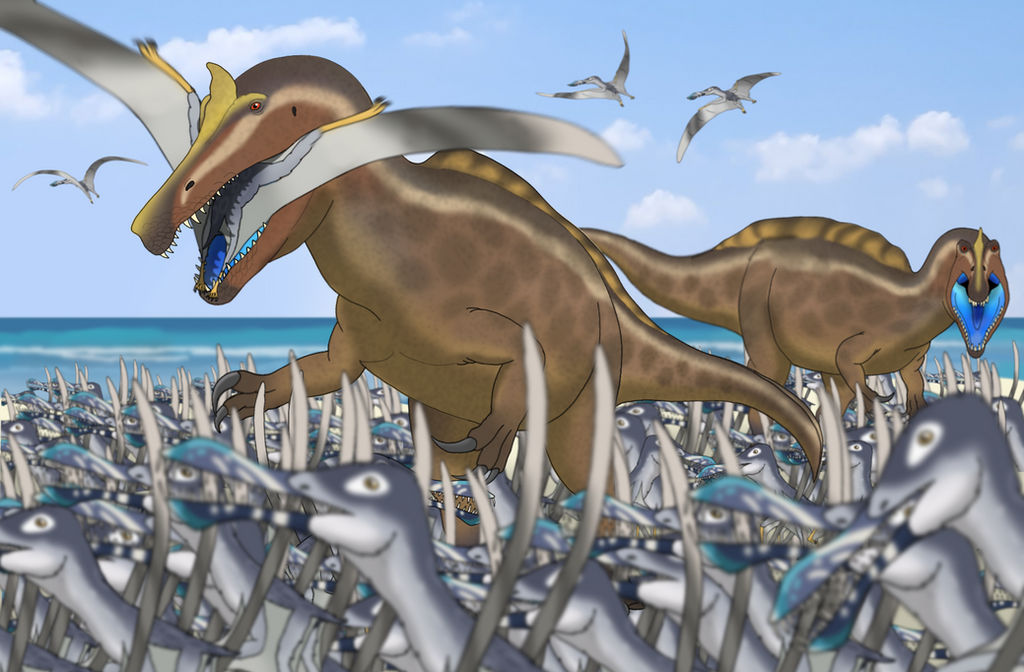HOME | DD
 Olmagon — Irritator Among The Flock
Olmagon — Irritator Among The Flock

#dinosaurday #beach #colony #cretaceous #dinosaur #irritator #jaw #lagoon #maw #mesozoic #paleoart #paleontology #pterosaur #spinosaur #spinosaurid #swallowed #swallowedwhole #swarm #theropod #angaturama #anhanguera #irritatorchallengeri #paleoillustration #spinosauridae #ornithocheiridae
Published: 2023-05-17 21:33:32 +0000 UTC; Views: 20235; Favourites: 405; Downloads: 22
Redirect to original
Description
After discovering a massive flock of Anhanguera piscator congregating on a beach to breed 112 million years ago during the early Cretaceous in what is now the Romualdo Formation of Brazil, a pair of Irritator challengeri decide to take the opportunity to eat something outside of their usual fish diet. One of the theropods manages to snag an Anhanguera and makes an attempt to swallow the pterosaur whole like its regular fish prey, but with those large wings in the way, it may need to resort to dismembering the pterosaur.Inspired by the recent paper redescribing the jaw mechanics of Irritator (quick summary here ), I (as well as half of all amateur paleoartists it seems) decided to make a drawing depicting this spinosaurid with its mouth open, and wanted to show it attempting to swallow a somewhat large prey item. Even managed to get it done in time for Dinosaur Day (May 17) and my own birthday. Ended making this drawing partly inspired by great white pelicans hunting gannets at their nesting colonies as well as the fact that an ornithocheirid pterosaur vertebra has been found with an Irritator tooth embedded which shows this dinosaur did at least occasionally hunt pterosaurs.
A spinosaurid dinosaur first named in 1996, Irritator challengeri got its unusual name from how irritated the people naming it were with the fossils (and this is not even the most ridiculous dinosaur name in a world where Thanos exists). It is generally thought to be 5 to 6 meters long, but if Angaturama limai were indeed synonymous with it then it may have gotten a bit larger than that. The Romualdo Formation where this dinosaur lived was a coastal lagoon habitat, and like other spinosaurs, Irritator had a long snout suited for catching fish which would have been its main prey, though it would also be capable of taking larger and terrestrial prey on occasion. Just 6 days ago, a paper was published on the jaw mechanics of Irritator and found that the animal was incapable of opening its mouth without the base of its lower jaws expanding outwards, which would have given the dinosaur a wide gape and likely facilitate swallowing decently large fish whole. As bizarre as this may sound, cranial kinesis (which is basically moving of the skull bones from each other) is quite common in living birds, lizards and most famously snakes, and has also been found to a lesser degree in other theropods, so Irritator opening its jaw into a diamond shape like a cormorant or heron is not really is bizarre as it being forced to do so in order to open its mouth (most birds and lizards can control this voluntarily). In fact the paper suggests that the whole spinosaurid family actually has similar mouth structures and it's possible all of them had this type of jaw. Though spinosaurs do have teeth and claws that can help dismember larger prey, I can also imagine them making attempts to swallow decently large prey whole considering how pelicans, cormorants and monitor lizards are all known to swallow ludicrously large items, and thus I just had to draw Irritator trying to do this.
Imma be honest, I have doubts that an Anhanguera breeding colony would be THIS densely populated or that all of them would just stand there while two spinosaurs eat some of their companions, but it was a cool mental image that I just really wanted to draw anyways. To be fair, seabird colonies are known to get quite crowded, and these flamingos seem decently chill around a baboon eating one of them (the latter's probably not directly comparable or great justification but still). It is however known that at least some pterosaurs formed breeding colonies since such sites have been found for Hamipterus and Pterodaustro, some numbering hundreds of individuals or varying ages, so I guess the colony size isn't TOO ridiculous.
I know it's not exactly obvious or a direct match but the colors of the Irritator were inspired by tiger herons, sunbitterns, anhingas and certain cormorants, with the inside of the mouth being based on breeding double-crested cormorants in particular. And honestly, of all parts of the body, the inside of the mouth does sound like a reasonable place for a theropod to have bright display colors since it won't affect camouflage much if the mouth is closed, as opposed to a speculative massive fleshy wattle on the throat. Also, drawing theropod heads directly from the front was tough and took me a while, guess you could say it was irritating and challenging (badum tss).
Much thanks to Olof Moleman (one of the authors of the jaw mechanics paper) for his help on this by the way, I managed to contact him and he helped quite a lot with the anatomical details of the two Irritator. And yes the Irritator fossil was illegally taken out of Brazil but unlike Martill (the 'Ubirajara' author), the authors of the Irritator jaw paper don't seem malicious and at least some have shown support for its repatriation, Moleman included.
Edit: My God some of those tags I just used look like vore stuff, what have I done.

























